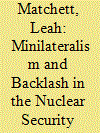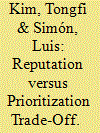|
|
|
Sort Order |
|
|
|
Items / Page
|
|
|
|
|
|
|
| Srl | Item |
| 1 |
ID:
184242


|
|
|
|
|
| Summary/Abstract |
How do alliance commitments affect US military spending? This question is at the heart of debates about the value of alliances and the future of US grand strategy. One perspective, which we call the budget hawk view, asserts that alliances are exorbitantly expensive, as they require military investments to deter third-party adversaries and reassure allies, encourage free riding, and facilitate reckless allied behavior. A competing view, which we label the bargain hunter perspective, claims that US alliance commitments are relatively cheap and might even reduce military spending. Allies provide key military capabilities, reassurance and extended deterrence are cheaper than they might initially seem, and alliances reduce the need for costly military interventions by promoting peace. Despite the importance of this debate, few studies have attempted to determine how alliance commitments affect US military spending. We use over-time variation in the number of US alliance commitments to estimate their financial toll. A statistical model of US defense expenditures from 1947 to 2019 shows that one new alliance commitment has a large positive association with defense budget levels in subsequent years. Military alliances benefit the United States in many ways but, consistent with the budget hawk view, they are expensive.
|
|
|
|
|
|
|
|
|
|
|
|
|
|
|
|
| 2 |
ID:
184248


|
|
|
|
|
| Summary/Abstract |
There is an intense debate in international relations scholarship on whether the benefits accrued by arms production globalization outweigh the risks of depending on foreign suppliers. Europe is an interesting case: although regional protection could help Europeans mitigate exposure to global actors, the prospect of regional integration generates concerns about autonomy within Europe itself. We depict European defense cooperation as a “two-level playing field,” whereby market size informs a country’s hedging between global-external and European-internal competitors. First tiers push for defense market integration because they expect to be strengthened vis-à-vis global players but also because market size gives them a competitive advantage over fellow Europeans. Second tiers resist market integration, as they worry it might lead to first-tier dominance. To probe our hypotheses, we examine the behavior of two first tiers (France and Germany) and two second tiers (Poland and Sweden) in the context of the European Defense Fund.
|
|
|
|
|
|
|
|
|
|
|
|
|
|
|
|
| 3 |
ID:
184247


|
|
|
|
|
| Summary/Abstract |
Frustration with large multilateral organizations is on the rise, leading some states to seek consensus in exclusive “minilateral” groupings. However, there is little to no research on how such an organization relates to the broader multilateral regime. I use the case of the Nuclear Security Summits (NSS) to examine the consequences of exclusion. I find states excluded from the NSS are more likely to criticize the Summits, even where they share policy preferences with included states. A comparison of follow-on initiatives shows that those more associated with the Summits are less likely to gain support from excluded states in the broader regime and that pushback is directly tied to the exclusion of the NSS. This suggests previously underappreciated costs of minilateral organization and the difficulties that can emerge when minilateral organizations attempt to affect a multilateral regime.
|
|
|
|
|
|
|
|
|
|
|
|
|
|
|
|
| 4 |
ID:
184243


|
|
|
|
|
| Summary/Abstract |
Existing scholarship on alliance burden sharing focuses on explaining why smaller allies often undercontribute relative to their larger partners. However, the literature largely neglects the role played by great-power pressure in shaping burden-sharing outcomes. I argue that rather than being a product of rational free riding, allies’ defense efforts are often a response to their patron’s threat of abandonment. When a patron can more credibly threaten to reduce its protection, and when doing so would impose serious costs on allies, the former is better positioned to elicit burden sharing. I test the theory using data on allied burden sharing in US alliances from 1950 to 2010. The results show that allies exhibit higher levels of burden-sharing efforts when they are geographically vulnerable to attack, whereas allies exhibit lower levels of burden sharing when they are in geostrategic locations valuable to the United States.
|
|
|
|
|
|
|
|
|
|
|
|
|
|
|
|
| 5 |
ID:
184244


|
|
|
|
|
| Summary/Abstract |
Under what circumstances is a protégé likely to perceive its patron’s extended deterrence commitments in another region as positive or negative for its own security? Protégés from distant regions see complementary reputational links between the credibility of a patron’s extended deterrence commitments in each other’s region. However, they are in a competitive relationship when it comes to the allocation of the patron’s resources. We call this the reputation versus prioritization trade-off. We argue that whether protégés assign more importance to their patron’s reputation or to being prioritized by said patron is a function of their dynamic perceptions of their regional security environment. These are, in turn, determined by their perception of their patron’s resource constraints and the threat posed by an adversary. To test our argument, we examine how Japan has perceived America’s evolving security commitment in Europe and how Poland has perceived the evolving US commitment in Asia.
|
|
|
|
|
|
|
|
|
|
|
|
|
|
|
|
| 6 |
ID:
184246


|
|
|
|
|
| Summary/Abstract |
Why do some individuals leave everything behind to join extremist organizations abroad? The literature on foreign fighters has grown impressively and yielded important insights in recent years. Three problems persist, however: (1) scholarship grounded in empirical fieldwork remains uncommon. This deficit reflects the scarcity of micro-level data based on individual profiles of jihadi recruits; (2) the studies available overwhelmingly center on Western jihadists even though the majority of foreign fighters who join groups such as the Islamic State in Iraq and Syria (ISIS) or al Qaeda hail from Arab countries; (3) an artificial rivalry between different explanatory approaches has produced an inconclusive picture of the determinants of radicalization. In this article, I reconsider the various pathways for transnational Jihadi recruitment by drawing upon a unique dataset pertaining to seventy Lebanese militants. I selectively combine elements from multiple perspectives to ponder the pathways of ISIS recruits, but my conclusions can be modified to apply to other circumstances.
|
|
|
|
|
|
|
|
|
|
|
|
|
|
|
|
| 7 |
ID:
184245


|
|
|
|
|
| Summary/Abstract |
What extended deterrence strategies are available to nuclear patrons, and what factors determine which strategy they adopt? How does each strategy manifest as force employment? The bulk of the literature on extended deterrence focuses on its effectiveness. The question of how nuclear patrons select between and employ strategies of extended deterrence, however, has largely been overlooked. Addressing the first, or strategy adoption, question, I argue that the interaction of two variables—(1) the type of threat posed to a client by an enemy; and (2) the likelihood of an enemy’s quick victory over a client—determines a nuclear patron’s strategy among four options: a conventional defense pact, forward conventional deployment, a nuclear defense pact, and forward nuclear deployment. Addressing the second, or strategy implementation, question, I argue that each strategy is embodied as the unique mixture of conventional and nuclear forces pre-positioned in either forward or rear areas. I test my theory of extended deterrence in two ways. First, I conduct a congruence test. Second, I perform two case studies—US extended deterrence to South Korea and the Philippines. I conclude with a discussion of policy implications for the current US security commitments to Seoul and Manila.
|
|
|
|
|
|
|
|
|
|
|
|
|
|
|
|
|
|
|
|
|